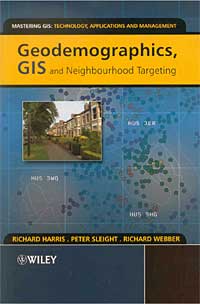|
Geodemographics, GIS, and Neighborhood Targeting Authored by Richard Harris, Peter Sleight, and Richard Webber Published by John Wiley and Sons, 2005 Reviewed by Prof Bin Li, Department of Geography, Central Michigan University, Mount Pleasant, Michigan, USA.
Chapter One attempts to establish the definition of geodemographics through application examples. Following the general definition of geodemographics as "the analysis of people by where they live," two hypothetical usage scenarios and case studies lead to a more operational concept that the main focus of geodemographics is neighborhood classification based primarily on demographic data. Chapter Two provides the historical context for the development of geodemographics and once again highlights neighborhood classification as the central theme. Chapter Three is a chronicle account on the development of the geodemographic industry, mainly in the United Kingdom. The authors attribute the development of the geodemographic industry to three forces: market demands, the development of computer technology and GIS, and increasing accessibility to census and non-census data. Subsequent chapters, four, five, and six, cover the methodological and technical settings in geodemographics. Chapter Four is an introduction to GIS in the context of neighborhood analysis. Within this chapter, the authors insert three sections: the statistical significance of cluster patterns, the uncertain interpretation of choropleth maps, and spatial interaction models. These by themselves are important topics but the logic of introducing them in this chapter seems unclear. Chapter Five introduces the concepts and principles of geodemographic information systems (GDIS). The basic functional components for data collection, analysis, visualization and output are discussed in detail. For readers who are not familiar with geodemographics software, these are very useful discussions. However, a comparison between a general purpose system and a specialized system seems to be superficial and unnecessary. Chapter Six details the main methodology for neighborhood classification. It is a comprehensive introduction to the topic. The methodology is clearly explained in a non-technical way and is accompanied by an example. Chapter Seven moves on to discuss issues with performing neighborhood analysis across countries and regions. Chapter Eight further addresses the academic criticisms on some of the key conceptual and methodological grounds in geodemographics outlined in this book. Chapter Nine introduces a new set of analysis methods that are based on lifestyle data. While lifestyle data provide addition information on the population, the real value perhaps lies in the geographic details. Unlike census data, which are aggregated, lifestyle data are available at the household level, which permits more robust analytical methods. The authors provide several sections on grid based analysis, Thiessen polygon analysis, and concentric circle analysis, which are all familiar methods for spatial pattern detection. While discussing the exciting prospects of new data and new approaches, the authors do not forget to articulate again the issues on data uncertainty, privacy, and security, which are the ultimate barrier to a successful geodemographic application. In the Postscript, the authors summarize the development of geodemographics as three I's: Inclination, Information, and Innovation. They are the synonyms of market demand, data availability, and computer technology, which were discussed earlier in the evolution of the field. The authors point out they will continue to be the factors shaping the development of geodemographics. Overall, the book provides a comprehensive introduction to geodemographics, though mainly from a UK perspective. Readers can use it as pointers to get in depth information elsewhere. Particularly valuable are the historical accounts on the evolution of the geodemographic industry in UK and around the world and the international perspectives. The authors do not shy away from the methodological and theoretical challenges. Their treatment of these challenges prepares the readers for a more balance and critical view on geodemographics so as to achieve a more reasonable expectation. In terms of the overall structure of the book, readers may occasionally find certain sections a bit out of place. Considering the difficulties in coordinating the materials from multiple authors who supply nearly a dozen case studies, the logical flow of the book is acceptable. In addition, the authors clearly attempt to strike a balance between readability and the integrity of the subject, on which they have achieved in a reasonable way. A clear place for improvement is the usage of maps, which will enhance the readability to a much greater extent. |
|
|
|
|

 This book is an overview on neighborhood targeting with geodemographics and GIS techniques. It established three related settings in this increasingly popular domain of neighborhood analysis. The historical and academic setting for geodemographics and GIS includes the urban geography traditions across the Atlantic and the relations between geodemographics and GIS, identified as the main tools for neighborhood targeting. The commercial setting involves the current market for neighborhood analysis, major companies and products, and the worldwide applications. The methodological setting focuses on the established techniques for neighborhood clustering and classification as well as the emerging trend on geolifestyle analysis. Formatted as a textbook with few technical terms and accompanying each chapter with case studies, the book should be accessible to a wide range of readers.
This book is an overview on neighborhood targeting with geodemographics and GIS techniques. It established three related settings in this increasingly popular domain of neighborhood analysis. The historical and academic setting for geodemographics and GIS includes the urban geography traditions across the Atlantic and the relations between geodemographics and GIS, identified as the main tools for neighborhood targeting. The commercial setting involves the current market for neighborhood analysis, major companies and products, and the worldwide applications. The methodological setting focuses on the established techniques for neighborhood clustering and classification as well as the emerging trend on geolifestyle analysis. Formatted as a textbook with few technical terms and accompanying each chapter with case studies, the book should be accessible to a wide range of readers.